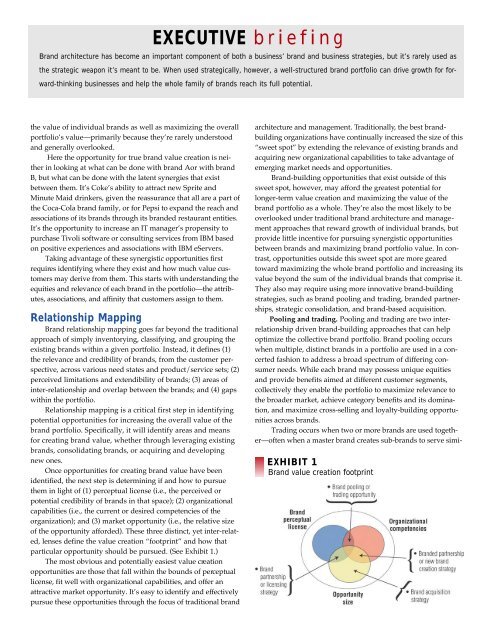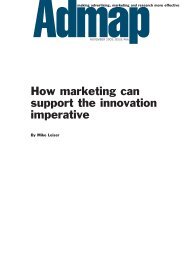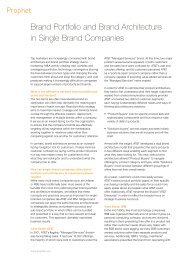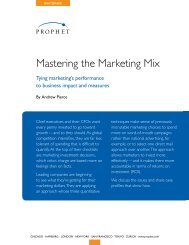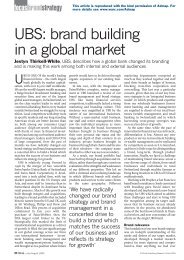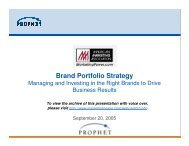Download - Prophet
Download - Prophet
Download - Prophet
You also want an ePaper? Increase the reach of your titles
YUMPU automatically turns print PDFs into web optimized ePapers that Google loves.
EXECUTIVE b r i e f i n g<br />
Brand architecture has become an important component of both a business’ brand and business strategies, but it’s rarely used as<br />
the strategic weapon it’s meant to be. When used strategically, however, a well-structured brand portfolio can drive growth for forward-thinking<br />
businesses and help the whole family of brands reach its full potential.<br />
the value of individual brands as well as maximizing the overall<br />
portfolio’s value––primarily because they’re rarely understood<br />
and generally overlooked.<br />
H e re the opportunity for true brand value creation is neither<br />
in looking at what can be done with brand Aor with brand<br />
B, but what can be done with the latent synergies that exist<br />
between them. It’s Coke’s ability to attract new Sprite and<br />
Minute Maid drinkers, given the reassurance that all are a part of<br />
the Coca-Cola brand family, or for Pepsi to expand the reach and<br />
associations of its brands through its branded restaurant entities.<br />
It’s the opportunity to increase an IT manager’s propensity to<br />
p u rchase Tivoli software or consulting services from IBM based<br />
on positive experiences and associations with IBM eServers.<br />
Taking advantage of these synergistic opportunities first<br />
re q u i res identifying where they exist and how much value customers<br />
may derive from them. This starts with understanding the<br />
equities and relevance of each brand in the portfolio––the attributes,<br />
associations, and affinity that customers assign to them.<br />
Relationship Mapping<br />
Brand relationship mapping goes far beyond the traditional<br />
approach of simply inventorying, classifying, and grouping the<br />
existing brands within a given portfolio. Instead, it defines (1)<br />
the relevance and credibility of brands, from the customer perspective,<br />
across various need states and product/service sets; (2)<br />
perceived limitations and extendibility of brands; (3) areas of<br />
inter-relationship and overlap between the brands; and (4) gaps<br />
within the portfolio.<br />
Relationship mapping is a critical first step in identifying<br />
potential opportunities for increasing the overall value of the<br />
brand portfolio. Specifically, it will identify areas and means<br />
for creating brand value, whether through leveraging existing<br />
brands, consolidating brands, or acquiring and developing<br />
new ones.<br />
Once opportunities for creating brand value have been<br />
identified, the next step is determining if and how to pursue<br />
them in light of (1) perceptual license (i.e., the perceived or<br />
potential credibility of brands in that space); (2) organizational<br />
capabilities (i.e., the current or desired competencies of the<br />
organization); and (3) market opportunity (i.e., the relative size<br />
of the opportunity afforded). These three distinct, yet inter-related,<br />
lenses define the value creation “footprint” and how that<br />
particular opportunity should be pursued. (See Exhibit 1.)<br />
The most obvious and potentially easiest value cre a t i o n<br />
opportunities are those that fall within the bounds of perc e p t u a l<br />
license, fit well with organizational capabilities, and offer an<br />
attractive market opportunity. It’s easy to identify and eff e c t i v e l y<br />
pursue these opportunities through the focus of traditional brand<br />
a rc h i t e c t u re and management. Tr a d i t i o n a l l y, the best brandbuilding<br />
organizations have continually increased the size of this<br />
“sweet spot” by extending the relevance of existing brands and<br />
acquiring new organizational capabilities to take advantage of<br />
e m e rging market needs and opportunities.<br />
Brand-building opportunities that exist outside of this<br />
sweet spot, however, may afford the greatest potential for<br />
longer-term value creation and maximizing the value of the<br />
brand portfolio as a whole. They’re also the most likely to be<br />
overlooked under traditional brand architecture and management<br />
approaches that reward growth of individual brands, but<br />
provide little incentive for pursuing synergistic opportunities<br />
between brands and maximizing brand portfolio value. In contrast,<br />
opportunities outside this sweet spot are more geared<br />
toward maximizing the whole brand portfolio and increasing its<br />
value beyond the sum of the individual brands that comprise it.<br />
They also may require using more innovative brand-building<br />
strategies, such as brand pooling and trading, branded partnerships,<br />
strategic consolidation, and brand-based acquisition.<br />
Pooling and trading. Pooling and trading are two interrelationship<br />
driven brand-building approaches that can help<br />
optimize the collective brand portfolio. Brand pooling occurs<br />
when multiple, distinct brands in a portfolio are used in a concerted<br />
fashion to address a broad spectrum of differing consumer<br />
needs. While each brand may possess unique equities<br />
and provide benefits aimed at different customer segments,<br />
collectively they enable the portfolio to maximize relevance to<br />
the broader market, achieve category benefits and its domination,<br />
and maximize cross-selling and loyalty-building opportunities<br />
across brands.<br />
Trading occurs when two or more brands are used together––often<br />
when a master brand creates sub-brands to serve simi-<br />
E X H I B I T 1<br />
Brand value creation footprint


